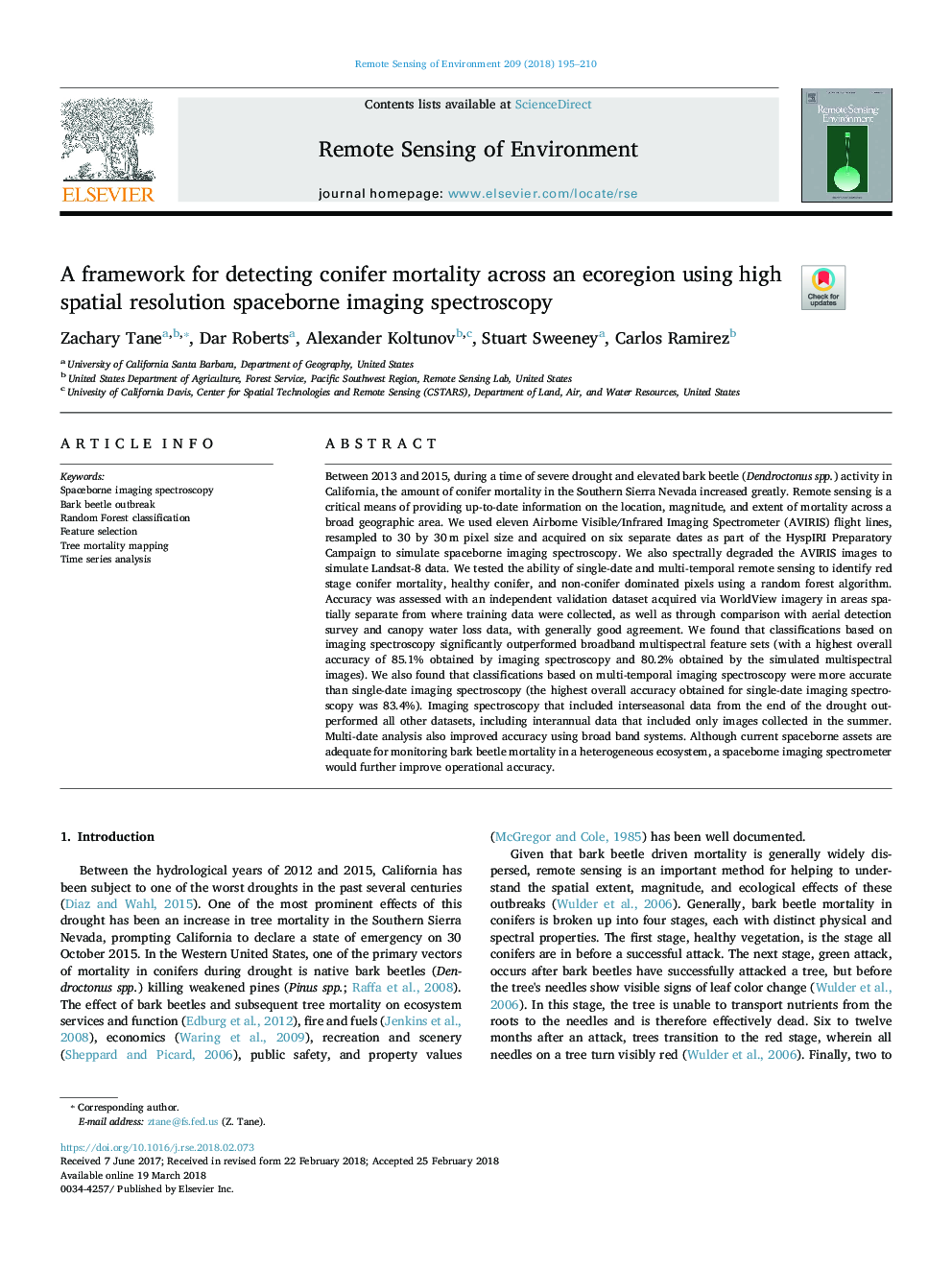| کد مقاله | کد نشریه | سال انتشار | مقاله انگلیسی | نسخه تمام متن |
|---|---|---|---|---|
| 8866634 | 1621191 | 2018 | 16 صفحه PDF | دانلود رایگان |
عنوان انگلیسی مقاله ISI
A framework for detecting conifer mortality across an ecoregion using high spatial resolution spaceborne imaging spectroscopy
ترجمه فارسی عنوان
چارچوبی برای شناسایی مرگ و میر مخروط در سراسر منطقه با استفاده از طیف سنجی تصویربرداری فضایی با وضوح بالا
دانلود مقاله + سفارش ترجمه
دانلود مقاله ISI انگلیسی
رایگان برای ایرانیان
کلمات کلیدی
موضوعات مرتبط
مهندسی و علوم پایه
علوم زمین و سیارات
کامپیوتر در علوم زمین
چکیده انگلیسی
Between 2013 and 2015, during a time of severe drought and elevated bark beetle (Dendroctonus spp.) activity in California, the amount of conifer mortality in the Southern Sierra Nevada increased greatly. Remote sensing is a critical means of providing up-to-date information on the location, magnitude, and extent of mortality across a broad geographic area. We used eleven Airborne Visible/Infrared Imaging Spectrometer (AVIRIS) flight lines, resampled to 30 by 30â¯m pixel size and acquired on six separate dates as part of the HyspIRI Preparatory Campaign to simulate spaceborne imaging spectroscopy. We also spectrally degraded the AVIRIS images to simulate Landsat-8 data. We tested the ability of single-date and multi-temporal remote sensing to identify red stage conifer mortality, healthy conifer, and non-conifer dominated pixels using a random forest algorithm. Accuracy was assessed with an independent validation dataset acquired via WorldView imagery in areas spatially separate from where training data were collected, as well as through comparison with aerial detection survey and canopy water loss data, with generally good agreement. We found that classifications based on imaging spectroscopy significantly outperformed broadband multispectral feature sets (with a highest overall accuracy of 85.1% obtained by imaging spectroscopy and 80.2% obtained by the simulated multispectral images). We also found that classifications based on multi-temporal imaging spectroscopy were more accurate than single-date imaging spectroscopy (the highest overall accuracy obtained for single-date imaging spectroscopy was 83.4%). Imaging spectroscopy that included interseasonal data from the end of the drought outperformed all other datasets, including interannual data that included only images collected in the summer. Multi-date analysis also improved accuracy using broad band systems. Although current spaceborne assets are adequate for monitoring bark beetle mortality in a heterogeneous ecosystem, a spaceborne imaging spectrometer would further improve operational accuracy.
ناشر
Database: Elsevier - ScienceDirect (ساینس دایرکت)
Journal: Remote Sensing of Environment - Volume 209, May 2018, Pages 195-210
Journal: Remote Sensing of Environment - Volume 209, May 2018, Pages 195-210
نویسندگان
Zachary Tane, Dar Roberts, Alexander Koltunov, Stuart Sweeney, Carlos Ramirez,
